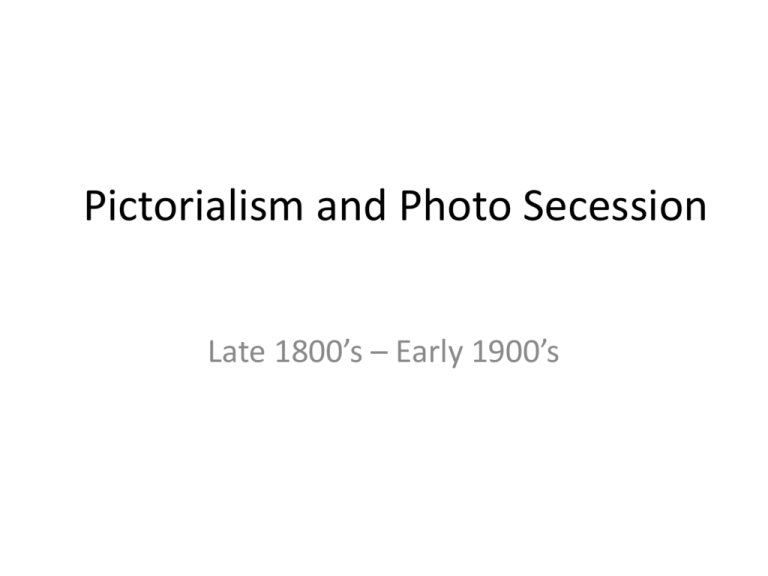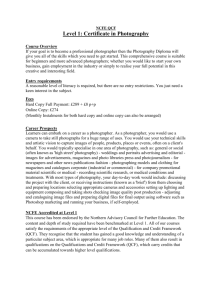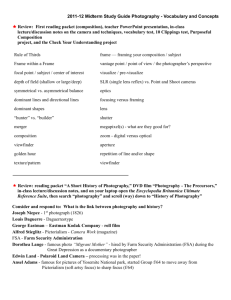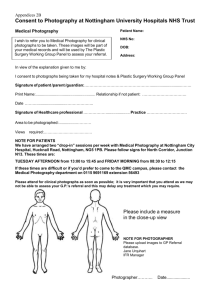Pictorialism and Photo Secession
advertisement

Pictorialism and Photo Secession Late 1800’s – Early 1900’s Invented 1839 Is it art or is it science? William Henry Fox Talbot “Impressed by natures hand” Louis Daguerre “Chemical and physical property which gives [nature] the power to reproduce herself.” Neipce “Spontaneous reproduce, by the action of light …” These inventors, or founders of Photography, unknowingly laid a foundation of this perception that Photography could not be art or self expression. This may have led to the movement we know of as Pictorialism. An early photograph produced on a silver or a silver-covered copper plate. Positive images produced directly onto the plate, could not be reproduced. Developed with warm mercury vapour. The earliest reliably dated photograph of a person, taken in spring 1838 by Daguerre “… the idea occurred to me... how charming it would be if it were possible to cause these natural images to imprint themselves durably, and remain fixed upon the paper." Henry Fox Talbot called his work the 'art of photogenic drawing’. His process produced prints on paper that were coated with silver iodide (salt and silver), which made it light sensitive. This process was called calotype - 1841. First to produce a negative that you could get prints from. Talbot went on to develop the three primary elements of photography: developing, fixing, and printing. Joseph Nicéphore Niépce 1826 - Niépce experimented with bitumen on pewter or zinc plates Lady Filmer – 1864 Lady Hawarden 1860 Wet Plate & Albumen Prints Gustave Le Gray 1859 Oscar Rejlander 1857 1888 – Kodak Camera Eastman Dry Plate Company – Made the Kodak camera – first handheld “instant” camera. Dry plates that were exposed by photographer and sent back to the company for development. The snapshot was born! Anyone could be a photography now … “You push the button, we do the rest!” http://www.kodak.com/ek/US/en/Our_Compa ny/History_of_Kodak/Milestones__chronology/1878-1929.htm George Eastman selling his camera on ocean liner – 1890 Art photographers were trying to get photography recognized as “Art”! This snapshot emergence from Kodak didn’t help their case! How could it be art if everyone could do it! Pictorialism • Mimicked Painting • Born as a reaction to the point and shoot approach to Photography made possible by Kodak. • Art Photographers wanted to make a distiction: • Make it a hard process! Not point and shoot! • Relied on labor intensive processes that showed the human hand in the process • Emphasized photographer as craftsman • Heavily worked negatives: Retouched negatives; printed on textured paper Gertrube Kasenbier, 1903 American Photographer Founding member of photo secessionists Heinrich Kuhn, 1898 Austrian First photographer to do unique “above” perspective Used Autochrome Kodachrome later replaced Autocrome Clarence White American Early 1900’s Self taught Opened first Photography School – Modern Photography Edward Steichen – 1904 Trained painter/drawer Editor of first photography publication – Cameraworks Magazine Opened first gallery, NYC 1st Fashion Photograph Military Photographer WWI & WWII Founded Photo Secession Movement First and highest paid fashion photographer Film maker Head of Photography Dept at MoMA Alred Stieglitz 1892 Grandfather of Art Photography Formed photography collection American camera club Advocate to push photograph as art medium Showed photography next to painting in his art gallery Equivalents “Are these clouds?” “I DON’T SEE WHY THAT MATTERS?” “What do you see? What does it make you feel?” “Equivalents idea or emotion attached to it by the viewer or photographer.” Pushed the way people that about photography and what it could be. Photo Secessionists







